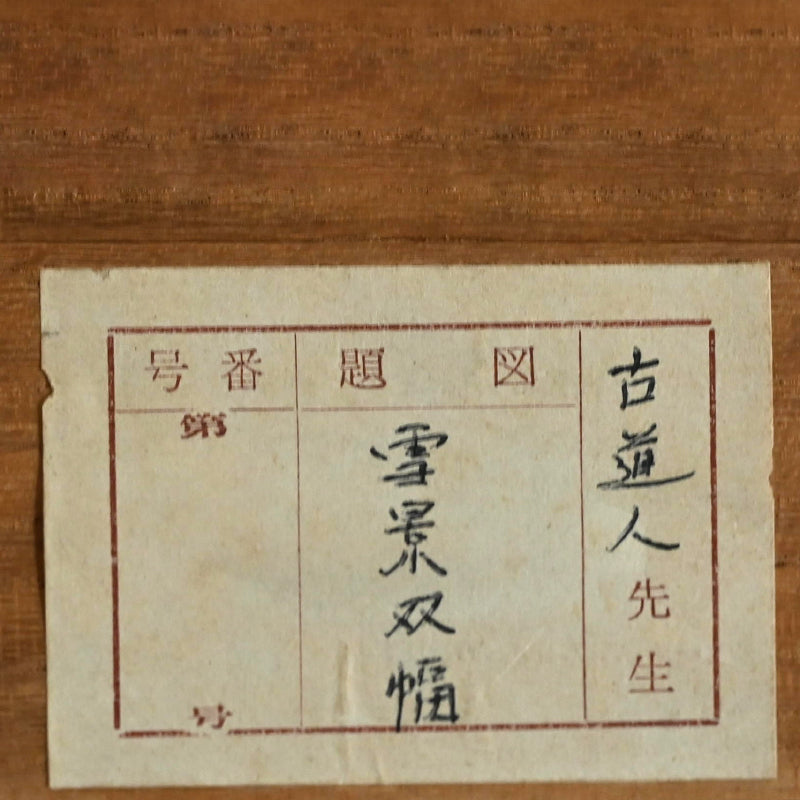Set of Winter Landscape Scrolls ー福田 古道人 “雪景山水双幅”
Set of Winter Landscape Scrolls ー福田 古道人 “雪景山水双幅”
Item Code: 古17
Couldn't load pickup availability
A window glows pink with warmth in the hermitage lost in the pair of vast winter landscapes by Fukuda Kodojin enclosed in the original signed wooden box titled Sekkei Sansui So-Fuku. In the first composition, jagged, snow-covered peaks rise into an empty sky, their stark forms rendered with Kodōjin’s distinctive textured ink wash—alternating dry brush and delicate rubbing to create both monumentality and ethereality. At the foot of the mountains, a modest thatched hut nestles into the snow. From within the hut, a single circular window glows with warm pink light, a touch of color so unexpected that it transforms the entire scene. It is as if the hermit’s inner world radiates a welcoming warmth into the frozen landscape. The accompanying poem amplifies this feeling of quiet endurance:
Alone I sit beneath the cold lamp;
Beyond the window, wind stirs the bamboo.
Deep in the night, I cannot sleep—
The snow piles high until all sound is gone.
The companion painting opens onto a wide river valley framed by softly contoured, snow-laden hills. A lone fisherman rows across the pale, frozen waters, his tiny boat dwarfed by the monumental calm of the mountains. Kodōjin’s brush alternates between calligraphic precision and mist-like softness, the empty space between inked forms suggesting cold air and silence. The poem inscribed above speaks of longing and remembrance:
The friend I hoped to see has not come;
At dusk my thoughts wander again.
I step outside the gate and seeー
The sky is cold, my robe heavy with snow.
Ink on paper with light pigment in a border of patterned royal blue terminating in ceramic rollers. The scrolls are 32 x 191 cm 13 x 75 inches) and in overall excellent condition.
Fukuda Kodojin (1865-1944) was an eccentric self-taught artist, his status as a poet, calligrapher and literati artist has reached legendary status. Born at a time of great change (4 years before the final fall of the Edo Government), he lived through the westernization of Meiji, Taisho Democracy, the rise of Imperialism and final defeat of the Showa eras. He was part of a small group of artists existing outside conventional circles in pre-war Japan. He moved to a village outside of Kyoto in 1901, where he supported himself and his family by privately tutoring those who wished to learn Chinese-style poetry. Kodojin was simply a scholar. His poetry, painting, and calligraphy all stem from a life-long cultivation of the mind. He was said to have taken the time just before his death to destroy the large portion of his own remaining work, leaving only that which must have met some personal criteria. Kodōjin’s paintings and calligraphy survive mainly in private collections, but significant works can be found in the collections of the British Museum, Freer Sackler Gallery of the Smithsonian Institute, Honolulu Museum of Art, Houston Museum of Fine Arts, Kumamoto Prefectural Museum of Art, Minneapolis Institute of Art, Museo Kaluz, New York Metropolitan Museum of Art, Portland Art Museum, Seattle Art Museum, St. Louis Art Museum, Tanabe City Museum of Art and Wakayama Prefectural Museum of Art among others including such well known Private collections as the Cowles Collection, Hakutakuan Collection, Manyoan Collection and Welch Collection. Twenty five paintings by the artist formed a private exhibition (from the Gitter-Yelen collection) at the New Orleans Museum of Art in 2000. In recent years, exhibitions such as The Last Master of the Literati Tradition: Fukuda Kodōjin (Minneapolis Institute of Art, 2023) have brought renewed attention to his achievement. For more on his life see the book Old Taoist, or Unexplored Avenues of Japanese Painting.
Share
















































































